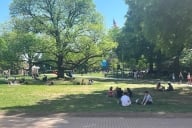You have /5 articles left.
Sign up for a free account or log in.
When I began my first non-tenure track job right out of graduate school, I was prepared for the financial and contractual precariousness associated with non-tenure track positions. I understood that at many institutions, I would not have the same status as tenure track faculty. One aspect of life as a contingent faculty member that I was not prepared for, however, was the number of miles I would walk just to do my job, and what impact that would have on my ability to present myself as a professional.
Over the course of the day, walking between classrooms, various academic offices, the library, the student center, and my own office, I can easily log two miles. I walk to and from campus, so that adds another two miles to my day. Why? A combination of campus scheduling realities, high transportation costs, and low salary.
Contingent faculty members are common on the campuses of large research universities, most often teaching courses that are part of a general education program. Such classes tend to be spread out across campus, rather than scheduled in classrooms near home departments and faculty offices. Oftentimes, contingent faculty don’t even have proper offices at all. And so we walk. A lot. And that’s once we get to campus. Non-tenure track faculty are also typically paid far less than our tenure track colleagues, which is why, when possible, I opt to live near enough to campus to walk rather than drive. A parking permit can cost hundreds of dollars per year, and even then, you might still have to walk a half mile or more to your office or classroom. Paying daily rates can be even more costly if you have to be on campus more than two to three days per week, as many of us are.
The fact that I average nearly four miles per day has been a surprising physical reminder of all of the challenges that contingent faculty can face, even in the best situations—and I write this with an acute awareness of my status as an able-bodied individual. Sartorially speaking, I’ve slowly come to terms with the fact that what I wear to campus is going to be dictated by the miles I have to walk in order to do my job. In warm weather, I can wear a dress, cardigan, and ballet flats and carry a tote bag. When it gets colder and wetter, I turn to skinny jeans and boots or “athleisure” shoes. When it snows and the sidewalks are treacherous, I have no choice but to don a pair of snow boots and carry a backpack. As the seasons change, my ability to command authority declines as I look more and more like a student.
The miles that non-tenure track faculty put in during a day also means that we are often rushed, and enter our classrooms out of breath, disheveled, and with little time to mentally prepare. That makes it difficult to employ many of the teaching strategies that we know support student learning, like using moments at the beginning and end of class to establish goals for the day or review material. Meeting with students is also difficult. Students aren’t always comfortable talking to us in public spaces near our classrooms but it might not be possible for them to walk back across campus to our offices and still make it to their next class or to their job. As a result, we lose valuable opportunities to support our students.
Universities could better serve contingent faculty in many ways. More—and more affordable— parking options and discounted public transit passes would help. Campuses should also invest more in their on-campus transit systems, and think not just about student users but also faculty and staff when determining routes and frequency. More attention needs to be paid to how we schedule classroom spaces, ensuring that contingent faculty have equal opportunity to provide input on where and when they teach. We can also look for creative solutions for making office spaces more convenient; for example, providing locations across campus for faculty to work and meet with students could minimize our mileage. With better communication between decision-makers and contingent faculty, we can do these things, and we can create non-tenure track positions that are better for both faculty and students. A good place to start though is by walking a mile—or two or three—in our shoes.
Caitlin Kelly is a Full-Time Lecturer in the Department of English at Case Western Reserve University where she teaches undergraduate seminars in the SAGES program. She is a regular contributor to the blog Pedagogy & American Literary Studies, and you can follow her on
Twitter @CaitlinLeeKelly.




